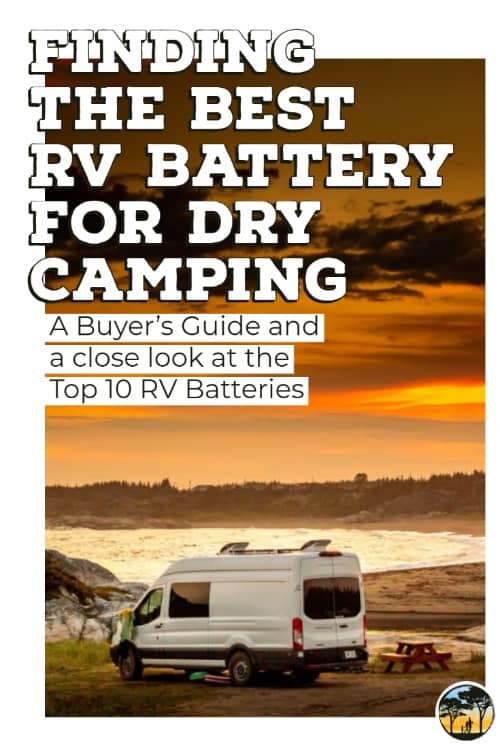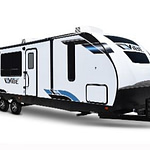Having a good battery for your dry camping can save you some headaches and quite a few bucks.
I say this because whether you boondock frequently or just stay overnight once in a while, batteries are the powerhouse of your RV. You want them to run strong and run for long hours.
If you are planning to become completely off-grid, for running your 120-volt appliances like microwave and electric water heater, investing in a quality battery setup is crucial.
However, your search for the best RV battery for dry camping/boondocking can be confusing. Firstly, there is a lot of jargon going on, from different types of batteries to electrical terms. Secondly, there are quite a few options out there when it comes to batteries in general. What complicates matters further is calculating all those amperes and voltages and selecting the right battery.
In this piece here, I have put in the effort, and after spending 37 hours on the research present my picks for the best batteries for dry camping. I also cover the most important aspects to consider when searching for the best battery for your setup.
So, without further ado, let’s get you and your RV off the hook and get into this!
Summary Table Best RV Battery for Dry Camping
The table below enlists my picks and some objective information about them. I will discuss each of these items in further detail to help you make an informed decision.
| RV Battery | Type | Capacity (Ah) | Check Price |
|---|---|---|---|
| Trojan T-105 Plus 6V | Flooded | 225 |  |
| Battle Born 12 V | LiFePO4 | 100 |  |
| Universal Power Group 12V | AGM | 100 |  |
| Renogy Li 12V | LiFePO4 | 100 |  |
| Weize 12V | AGM | 100 |  |
| KILOVAULT 1800 HLX | LiFePO4 | 150 | 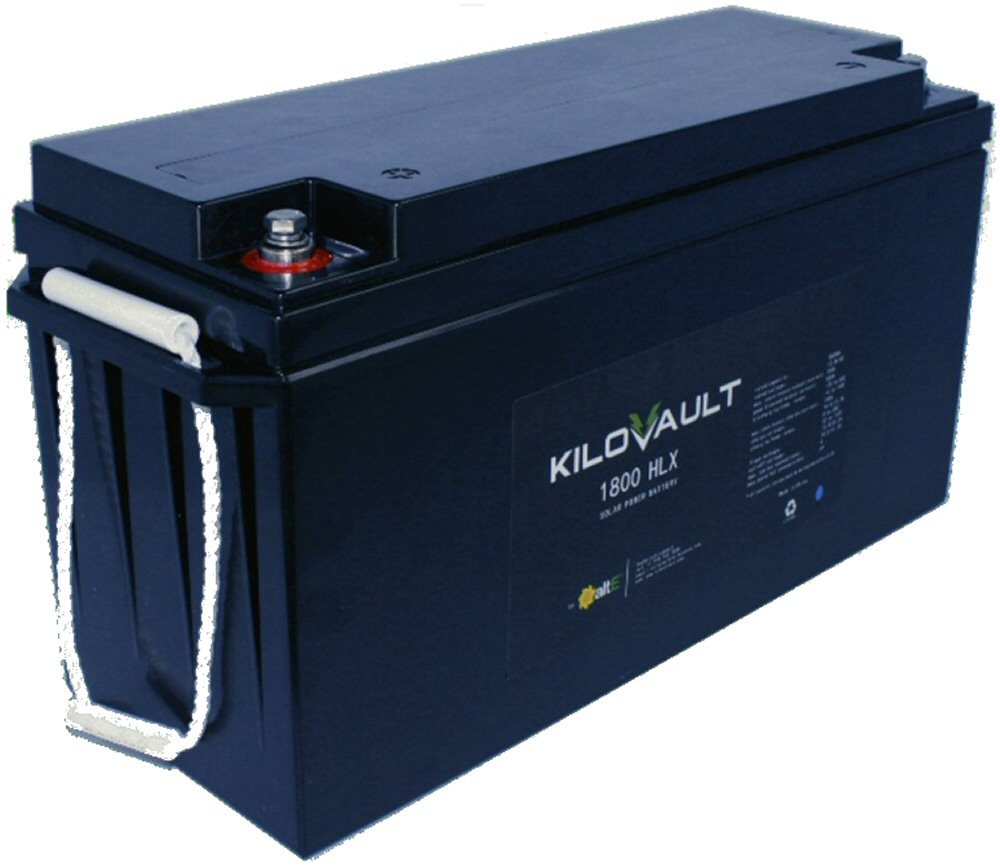 |
| Interstate 12V | AGM | 110 |  |
| ExpertPower 12V | LiFePO4 | 100 |  |
| Renogy 12V | Hybrid Gel | 200 |  |
| SOK Battery 12V | LiFePO4 | 100 |  |
Top 10 Picks for Best RV Battery for Dry Camping
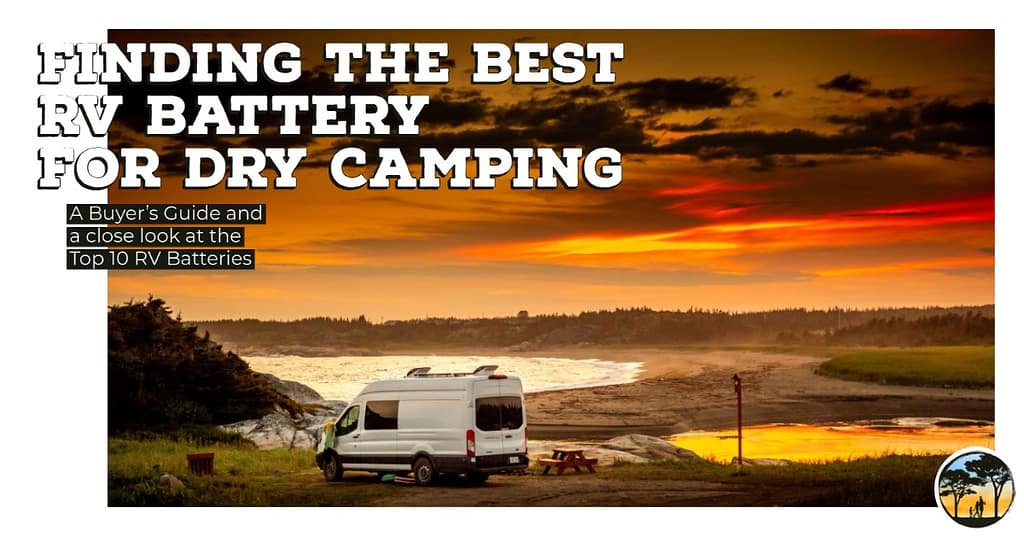
1. Trojan T-105 Plus 6V Deep Cycle Battery x 4
If you are looking for a dependable brand with the latest technology, Trojan T-105 Plus should be your go-to option. It provides a good combination of power and longevity you can expect from Trojan and any good deep cycle battery. It discharges at a slow speed and that provides you the hours you need out of your charged battery for boondocking. You would love that it is compatible with generators, solar, and wind. Yes, it is a bit heavy and on the pricey side, but these shortcomings aren’t deal-breakers, especially when you get unmatched peace of mind and dependable performance.
Trojan manufactures a huge range of batteries, but Trojan T-105 is their best-selling model by a distance. The Trojan T-105’s are what they call golf cart batteries, but have long been used for RVs.
It must be noted that these are 6-volt RV batteries and most RVs have 12-volt electrical systems that run on battery. Therefore, you must at least have two of these batteries and connect them in series to make them work. You can do this by connecting the positive terminal of one battery to the negative terminal of the other battery with an interconnect cable. Then, you just need to connect the positive from the trailer/RV to one battery and the negative to the one battery.
This battery essentially is a flooded or wet lead-acid battery. In these batteries, there is an electrolyte solution that floods/wets all internal parts. The biggest advantage with the flooded batteries is that they are reliable with long deep discharge cycle life and low cost.
This battery comes with a capacity of 225 amp-hours (Ah) for 20 hours. We will talk more about amp-hours later on, but for easy understanding, you need to know that a higher Ah value means longer hours from the battery compared to a lower Ah value with a single charge. For a general reference, anything above 100 Ah is considered good.
Trojan T-105 Plus is a deep cycle battery and It is important to point out that for RVs you should go with deep cycle batteries. These batteries are different from automotive batteries because of their composition and long discharge time. Trojan T-105 Plus gives 600 to 1000 charge-discharge cycles depending on the depth of discharge (DoD) of every cycle.
In T-105 Plus, Trojan has switched the cap system to a single-hinged staggered cap. Furthermore, it has an indicator inside to not overfill the water.
What separates Trojan from the competition is its three-fold technique in the quality of manufacturing.
In this, we have the Maxguard T2 separator. This separator keeps the plates from shorting out. This is important as over time plates get compressed and start to decay and this separator keeps the plates from touching each other and shorting out. Besides, T-105 uses Alpha Paste Plus which is a high-density active material on the plates that ensures high conductivity. Thirdly, they use a thick grid structure on the plates that strengthens the frame and slows down corrosion. As a result, there is improved current flow, good overall performance, and reduced downtime and maintenance costs.
On the downside, Trojan T-105 Plus is heavy at 62 pounds for a single battery. In addition, it requires regular maintenance in the form of watering and keeping its terminals clean. Moreover, it is a bit on the pricier side considering what it has to offer.
Pros
Cons
Related: RV Accessories: Must Haves for your new RV
2. Battle Born LiFePO4 100 Ah 12 V Deep Cycle Battery
Battle Born LiFePO4 100 Ah 12 V Deep Cycle battery is a no-brainer for anybody who is looking to move completely off-grid/full-time boondocking. All you have to do is attach some of these batteries in parallel and get the best battery bank. No doubt, there will be a big upfront cost with these batteries, but they will serve you well and serve you long.
Coming out of Reno, Nevada, Battle Born Batteries have made a name for themselves in a short amount of time. They produce a variety of batteries that incorporate lithium ferro phosphate (LiFePO4) technology which is considered one of the best technologies you can get in batteries right now.
The battery we have at hand is their 100 Ah deep cycle battery. The stand-out feature of this battery is its efficient Battery Management System (BMS). BMS makes sure that the battery is not overcharged or undercharged. Battery damage occurs when charging goes down to a certain level. This is what BMS prevents from happening.
BMS also provides the low-temperature disconnect. Most batteries when charged in freezing temperatures become permanently damaged. In Battle Born, the low-temperature disconnect prevents that from happening.
So, in essence, Battle Born batteries have quite a few safety features which prevent any detrimental event from happening. These include overcharging, deep discharging, overloading, overheating, and short-circuiting.
The biggest advantage I see with Battle Born Batteries is that all of their batteries come with a massive 10-year warranty, which is a huge relief in itself. However, this warranty essentially is for any BMS failures.
One feature that makes this lithium battery stand out from the competition is its ability to be connected in series. Most lithium batteries allow parallel connections, but not series connect. Thus, you can connect these batteries in series and even make a 24-V and that’s perfect for going completely off-grid.
Related: These are the RV kitchen accessories you need right now
This battery has a capacity of 100 Ah, which is low compared to the 225 Ah of Trojan T-105, but you have almost all of these 100 Ah available. Plus, lithium batteries don’t have to deal with the Peukert’s effect, which essentially means lesser capacity over time for lead-acid batteries. Lithium batteries, on the other hand, remain constant year after year.
One big downside of the lithium-ion batteries is their high upfront cost. It is not uncommon for lithium-ion batteries to cost in excess of $1000. However, if we consider their exceptional longevity and unlimited mounting capacity, lithium-ion batteries are more cost-effective than other batteries in the long run.
On top of all that, LiFePO4 batteries incorporate safer chemistry with non-toxic chemicals and ultimately are recyclable. Thus, you have renewable environment-friendly energy in the truest sense. Another big plus this battery has is its lighter weight at only 31 pounds.
Pros
Cons
3. Universal Power Group UB 121000 Deep Cycle AGM Battery
UB 121000 has quite a few plus points that make it an attractive option for anybody with a small setup. It is maintenance-free, spill-proof, and provides constant voltage with a good overall capacity. You can be critical of its shorter life span and heavier weight, but the price it comes at justifies some of the shortcomings it has.
UB 121000 is an AGM or absorbent glass mat battery as the best RV battery for boondocking, especially if you are planning to go completely solar. AGM batteries basically are lead-acid but they have a fine fiberglass mat that absorbs the acid and makes them spill-proof.
AGM batteries generally have low internal resistance, are able to deliver high currents, and offer long life. Moreover, unlike flooded lead-acid batteries, they are maintenance-free and as they are spill-proof they can be mounted in any position. On top of all that, they charge super-fast compared to flooded batteries.
AGM batteries generally have low internal resistance, are able to deliver high currents, and offer long life. Moreover, unlike flooded lead-acid batteries, they are maintenance-free and as they are spill-proof they can be mounted in any position. On top of all that, they charge super-fast compared to flooded batteries.
UB121000 has a capacity of 100 Ah and is a 12-volt group 27 battery. The group number for a battery basically refers to its physical dimensions, the voltage of that battery, and your post configuration and location like terminal types and locations. So, all batteries with the same group number will always have the same values for these specifications. For most RVs, we either use group 27 or group 24 batteries.
AGM batteries are generally sensitive to overcharging and therefore overcharging of any sort will damage them and shorten their life. Talking of life span, UB121000 will give you two to three years of service and has about 500 cycles at 50% DoD.
This battery presents as a good option for a small off-grid solar system. The newer deep-cycle AGM batteries like UB121000 are able to deal with different inconsistencies related to solar energy. These include unstable grid energy, heavy charging, and discharging cycles, and irregular full recharging. And as they are maintenance-free and flexible with their position, you can install solar applications in hard-to-reach places as is required in such situations without having to worry about regular maintenance.
For your travel trailer and RV use, because this battery does not have any water inside it sloshing around, it does withstand vibrations and movements pretty well.
Related: Best Dry Camping Travel Trailer: 5 Picks for your off-grid adventures
On the downside, this battery is on the heavier side even for an AGM battery and loses its ability to retain charging overtime.
Price is easily the best thing about this battery. It comes at a highly affordable price and this makes it even more attractive for anybody who is looking for a battery for a small setup.
Pros
Cons
4. Renogy 12V 100Ah Smart Lithium Iron Phosphate Battery
Renogy’s lithium battery provides good value for the money. The overall construction, performance, and safety feature tick most of the boxes for a quality battery. It provides the longevity you need when you are considering full-time boondocking. You just need to attach a few of these batteries in parallel and you can run even the most current-hungry appliances.
Renogy started as small but now finds itself compared to some of the giants of the industry. They produce a variety of electrical applications including solar panels, inverters, and battery chargers, but it is their deep cycle lithium batteries that are the real deal.
The best thing about them is their price, which is quite reasonable considering the competition and the quality they have to offer. Practically, they cost only $0.70 per watt-hour, which is among the best in the market.
They produce their lithium iron phosphate batteries in three capacities and these include 50 Ah, 100 Ah, and 170 Ah. For this list of the best RV batteries for dry camping, we are going with the 100 Ah battery.
As you can guess, this is a 12-volt deep cycle battery and perfectly ticks most of the features we are looking for.
Along with the price, the best thing about this battery is its construction. They have incorporated quality material throughout, starting from the cover to the plates which are contained in a pouch cell. This makes the battery compact and combined with its lightweight of just 28.1 lbs is easy to carry.
Related: RV Bathroom Accessories and Bedding Essentials
Its battery management system and safety certifications ensure that you just can’t screw it up. It prevents voltage variations and protects the battery from shorting out, undercharging, and overcharging. I have to say its BMS matches some of the high-end lithium batteries out there.
Just like any lithium battery, you can expect a long life from this battery. It provides 7000 and 4000 cycles for 50% and 80% DoD respectively.
The only downside I find with this battery is its inability to be connected in series. Not that it affects its claim to be a good boondocking battery setup, but you can’t use it to increase the voltage to 24 V if you wanted to use it in your off-grid house/setup.
Pros
Cons
Related: Best Camping Mattress for Couples
5. Weize TL12100 12V 100AH Deep Cycle Battery
Weize TL12100 is an AGM SLA (sealed lead acid) battery that is non-spillable and made for general use.
It is a 12-volt battery with a capacity of 100 Ah. However, as it is an AGM battery, you won’t have all of these 100 amp hours at your disposal or you carry the risk of permanently damaging your battery.
Like any AGM battery, it is maintenance-free and you can connect it in parallel and in series to create battery banks to get better capacities and higher voltages.
Weize TL12100 has physical dimensions of 12.09 x 6.65 x 8.31 inches and belongs to the BCI Battery Group 31. These dimensions are very close to the Group 27 batteries, but TV12100 incorporates somewhat taller terminals.
It weighs 60 pounds or around 27 kg and comes with a substandard carrying handle, so you can’t comfortably carry it for longer distances by yourselves.
You can use this as both your standby battery or as your deep cycle battery. However, as it is a true deep cycle battery, it should not be used for cranking.
The good thing about this battery is its calcium-lead alloy grid which gives a low self-discharge rate and long service life. However, the battery should not be deeply discharged beyond 50% too often.
You will get a one-year warranty with this battery and it is suitable for a variety of applications including as an RV house battery.
Pros
Cons
6. KiloVault 1800 HLX 12V 150 Ah Lithium Solar Battery
Next up, we have a LiFePo4 battery from KiloVault. Thanks to its BMS, it comes with all the safety features we have discussed with Battle Born and Renogy lithium batteries. Simply put, there is a lot to like about this deep cycle battery for dry camping and you would do yourself a world of good by going with KiloVault 1800 HLX.

The LiFePo4 battery from KiloVault comes in two configurations by the names of 1800 HLX and 3600 HLX. They have capacities of 150Ah and 300 Ah respectively. They are specifically designed for renewable energy use, so they are perfect for any off-grid solar systems.
Both of these batteries can be the drop-in replacement for flooded or sealed lead-acid batteries. Moreover, they do not need any specialized chargers.
Here, we will be talking about the 1800 HLX in more detail. This battery comes with a rating of 12 volts, but you can wire up to four of these in series for up to 48-volt systems, which is pretty impressive. Plus, you can string four in parallel. Thus, you can have up to 16 of these in your battery bank. That gives you a massive 28.8 kWh. Now, you imagine what you can get out of all this power.
1800 HLX has physical dimensions of 19.1in x 6.7in x 9.4 inches which are bigger than normal batteries. In addition, it weighs more than some of the other lithium batteries at 41.7 lbs. But, it is still lighter than similar lead-acid batteries.
This battery comes at a price of about $1300. Considering the quality this battery has to offer, this is an attractive price point. This essentially equates to a price of $0.72 per watt-hour, which is lower than what you get with the Battle Born 100 Ah battery. Plus, they have a slightly better discharge rate of 1.1 C.
Besides, like other lithium batteries, you have all the capacity available at your disposal with 100% DoD. However, to get the maximum time out of these batteries, it is better to discharge them up to 80% and that would give you a life of 5000 charge-discharge cycles.
To put it into perspective, even if you cycle the battery every day this will give you a battery life of over 13 years. Plus, you will have the same constant performance year after year.
Pros
Cons
Related: The Best Camping Chair for Bad Back: Top 10 Picks
7. Interstate DMC0100 12V 110 AH Deep Cycle Battery
This Interstate RV battery is a good backup option to have on your days out dry camping. It does have some shortcomings as you can expect from an AGM battery like short life cycles and being heavy, but with a good price point and Interstate’s brand confidence going with this as your backup battery should be a no-brainer.
Interstate Batteries has been a name-brand for some decades and it is only in the last decade they introduced their line of deep cycle batteries. They come in a variety of configurations. For this list of the best RV batteries for dry camping, we have picked up their 12-volt 110 Ah AGM and VRLA (valve regulated lead acid) battery.
As said before, AGM batteries are better than the flooded lead-acid batteries in terms of being maintenance-free and non-spillable. Therefore, you can mount them in any position and this gives you flexibility with installation.
As this battery incorporates calcium alloy, there is negligible to no gas emission, so you can place it both indoors and outdoors.
DCM0100 comes in a thermally welded convenient case and this good construction further prevents any spillages and leaks.
It is noteworthy that Interstate batteries are U.L. recognized and CE certified. However, they come with a short warranty of only one year. Moreover, DCM0100 is heavier in weight and has a shorter charge-discharge cycle life of about 500 cycles at 80% DoD.
Pros
Cons
8. ExpertPower EP 12100 LiFePO4 100 Ah Deep Cycle Battery
ExpertPower EP 12100 is a deep cycle lithium battery that has some strong points but also carries some shortcomings. However, considering it comes at a fairly low price for a lithium battery, gives good life cycles, and has got most bases covered, it still is a good option for a boondock setup that is not too power-hungry. Plus, being maintenance-free and safety-certified gives you that peace of mind.
Not too long ago, lithium batteries were hard to find and were essentially out of the reach of a commoner. However, over the last few years, we have seen a surge in the number of companies manufacturing lithium batteries and the price has also come down considerably.
ExpertPower produces quality lithium batteries and at an affordable price. They produce a whole range of lithium battery and you can get your hands on one for as low as $100 which is the price of their 100 Ah lithium battery. For this list, we have gone with the 100Ah deep cycle battery which utilizes the LiFePo4 chemistry.
This battery is cost-effective considering what it has to offer. In addition, you would be glad to know that it is UL listed and safety certified. So, that should rest any doubts about the overall quality of this battery.
But, here is the catch, because it comes at a lower price, it has some shortcomings compared to other big names. Among these, we see that although it is rated as 100 Ah, it only discharges a max of 70 amps. Plus, it has a charge rate of only 50 amps. Therefore, you will have to attach multiple batteries in parallel for larger loads.
Among other things, this battery only connects in parallel and that too with a max number of four batteries. However, as they are 12 volts in themselves, the inability to connect in series does not damage their claims of being a good RV battery.
The battery comes with battery management systems, so it has all the necessary protection against different faults.
Pros
Cons
9. Renogy 12 V 200AH Deep Cycle Hybrid Gel Battery
Our next entry is a hybrid gel battery from Renogy and has a capacity of 200 Ah. Gel batteries are, sort of, a combination of flooded lead-acid and AGM technologies. Hybrid gel batteries have AGM separators and contain liquid gel in the form of colloidal silica electrolytes.
This essentially creates a battery with a relatively stationary fluid. The thing with hybrid gel batteries is that you can place them side on and upright, but they should not be placed upside down to prevent leakage. Pure gel and hybrid gel batteries beat other lead-acid batteries in having a slow discharge rate and operating over a wide range of temperatures/weathers.
This battery is a deep cycle battery and can be used for standby and cyclic use applications including RVs and trolling motors.
This Renogy battery is able to withstand shocks and vibrations and this further adds to its suitability as a good RV battery. I say this because you are constantly moving and this ability prevents any damage to the battery.
Related: RV Departure Checklist – Get on the road safely!
As stated, it has a capacity of 200 Ah but you can essentially take this battery to 50% DoD because it starts to damage the battery beyond that. Therefore, you basically have 100 Ah at your disposal. Nonetheless, you can connect them in series and in parallel for increased voltage and capacity.
Compared to most of the lead-acid batteries out there, this battery has a long shelf life of 12 years and gives you 750 charge-discharge cycles at 50%. Both of these values are on the higher end for any lead-acid battery. Some of this is down to its lead-calcium grids which ensure only mild corrosion overtime.
This battery comes with a three-year material warranty that covers any internal cell problems and if the battery fails to hold the charge.
Among shortcomings, we can see that this battery weighs huge at 127.9 lbs.
Pros
Cons
10. SOK 100Ah 12V LiFePO4 Deep Cycle Battery
SOK 100 Ah battery is a good budget lithium battery. It comes in a beefy metal case and provides constant power through most of its capacity. BMS functions without fail and the battery provides a long cycle life. We do see some cost-cutting measures, but you can expect that at a price like this. Other than that, there is nothing major wrong with the battery, and can turn out to be a good decision.
The last entry on our list of best RV Battery for dry camping is from a relatively unknown company, but it shows good promise and that too a good price point.
This is essentially a 12-volt 100Ah battery that incorporates LiFePO4 chemistry. It comes in a sturdy metal case and has four cells with each of them providing 320 watt-hours with a total capacity of 1280 watt-hours. These cells have rubber paddings around them and they are nicely locked in place.
Like most lithium batteries nowadays, the SOK battery comes in with a built-in battery management system that protects against different faults. These include events such as shorting out, overcharging, undercharging and low temperatures which are detrimental to the battery.
One thing I personally like about this battery is that you can easily pull it apart with its detachable cover and work on things yourselves. Plus, you can also get replacement cells and BMS from Amazon.
The battery itself is lightweight at around 26 pounds and has a long life of 4000 to 8000 cycles as can be expected from a lithium battery.
On the downside, as opposed to some of the top names, which give you about 100% of the capacity, the SOK battery gives you around 95% before the voltage starts to drop below 12 volts. Moreover, the internal buzz bars are not of good quality and we see undersized internal cables.
Pros
Cons
Related: 37 best gifts for campers
How to Pick the Best RV Battery for Dry Camping
Above I listed my picks for the job. However, I am not here to tell you what I like, but to help you make informed decisions for any future battery purchases.
In this section, I will go over different factors you need to consider when going for your next RV battery for dry camping.
Why You Need A Deep Cycle Battery For RVs
The first thing you need to know before buying a battery for any camper is that it should be a deep cycle battery. In other words, you can’t use a car battery for this purpose.
Deep cycle batteries are able to discharge and recharge frequently. Car batteries, on the other hand, only provide a short burst of power to crank over.
Deep cycles batteries are made using thick plates and have dense active material and this makes them withstand frequent charge-discharge cycles. They deliver constant power over extended periods of time which car batteries can’t provide. Therefore, you need a deep cycle battery for your RV.
6-Volt Battery Vs 12-Volt Battery for Dry Camping
An RV generally has two types of appliances, ones which run on 120 volts and the other which run on 12 volts. Your camper comes with a 12-V battery or two and they usually run your 12-volt appliances. For 120-volt appliances, you need an inverter that would convert your battery power to match this number.
Thus, you need at least a 12-volt battery setup power to run your appliances. However, you can get this through a single 12-volt battery or by connecting two 6-volt batteries in a series. And both of these have their advantages and disadvantages over each other.
6-volts batteries generally last longer and have a higher number of charge-discharge cycles than 12 volts. They, on the other hand, are relatively more expensive and are not as readily available as 12-volt batteries.
I would say it is down to your personal choice and you can go with either a 6-volt or 12-volt battery.
Different Battery Types for Dry Camping
Deep cycle batteries come in different classes and each of them uses different chemistry and has its pros and cons. Below, I will discuss these battery types and that will give you an idea about which one you should go with depending on your level of boondocking.
1. Lead-Acid Batteries
These storage batteries work by dipping the lead oxide plate and sponge lead plate in dilute sulfuric acid. This battery essentially converts chemical energy into electrical energy and stores it.
Advantages
- Long life
- Low cost
- Large current capability
- Easily available
- Low self-discharge
- Can be charged with a trickle charger
Disadvantages
- Low energy density
- High maintenance
- Heavy
- Can’t be fully discharged
Lead Acid Battery for Dry Camping
Lead-acid batteries can’t be placed indoors because they produce gas fumes. In addition, they are large and heavy. Plus, you have to deal with regular maintenance. What complicates matters is the fact that their acid is spillable.
Considering these factors, they are probably not the best of options if you are planning to go with full-time boondocking. However, if you dry camp once in a while or spend a day or two at max, because they are low cost and provide stable currents, they are probably the ones to go with.
In our list, Trojan T-105 Plus is a good lead acid battery and is widely used by dry campers.
2. Absorbed Glass Mat (AGM) Batteries
This battery essentially is a lead-acid battery, but it utilizes a fine fiberglass matt that absorbs the sulfuric acid and makes this battery non-spillable.
Advantages:
- No regular maintenance
- Can be placed indoors
- High specific power with low internal resistance
- Charge faster than flooded lead-acid batteries
- Can tolerate cold temperatures
- Withstands shocks and vibrations
Disadvantages:
- Cost is higher than flooded lead-acid batteries
- Low specific energy
- Sensitive to overcharging
AGM Batteries for Dry Camping
AGM batteries can be a better option for dry camping compared to flooded lead-acid batteries. I say this because of their spill-proof design and no-maintenance chemistry. They don’t last as long as lithium batteries, but they have a much lower upfront cost too.
3. Lithium Batteries
Lithium ions move through an electrolyte from a positive electrode to a negative electrode in charging and from a negative electrode to a positive electrode during discharge. Lithium batteries come in a variety of chemistries, but the most common one used is lithium iron phosphate which is considered safer and more practical.
Advantages:
- Long life
- Maintenance-free
- Low self-discharge
- High energy density
- Lightweight
- Good charge efficiency
- Safe
- Environmental friendly
- Deep discharge
Disadvantages:
- Higher upfront cost
- Sensitive to extreme temperatures
Lithium Batteries for Dry Camping
Lithium iron phosphate batteries are by the far the best RV batteries for dry camping. They require no maintenance, hold charge efficiently, and have a long life. They can be charged using any source including solar, wind, and generator. They do have a higher upfront cost, but if you are considering moving to dry camping/boondocking full-time, they are more cost-effective in the long run and you can rely on them. Just add more batteries to your setup with an inverter and you can run anything on them.
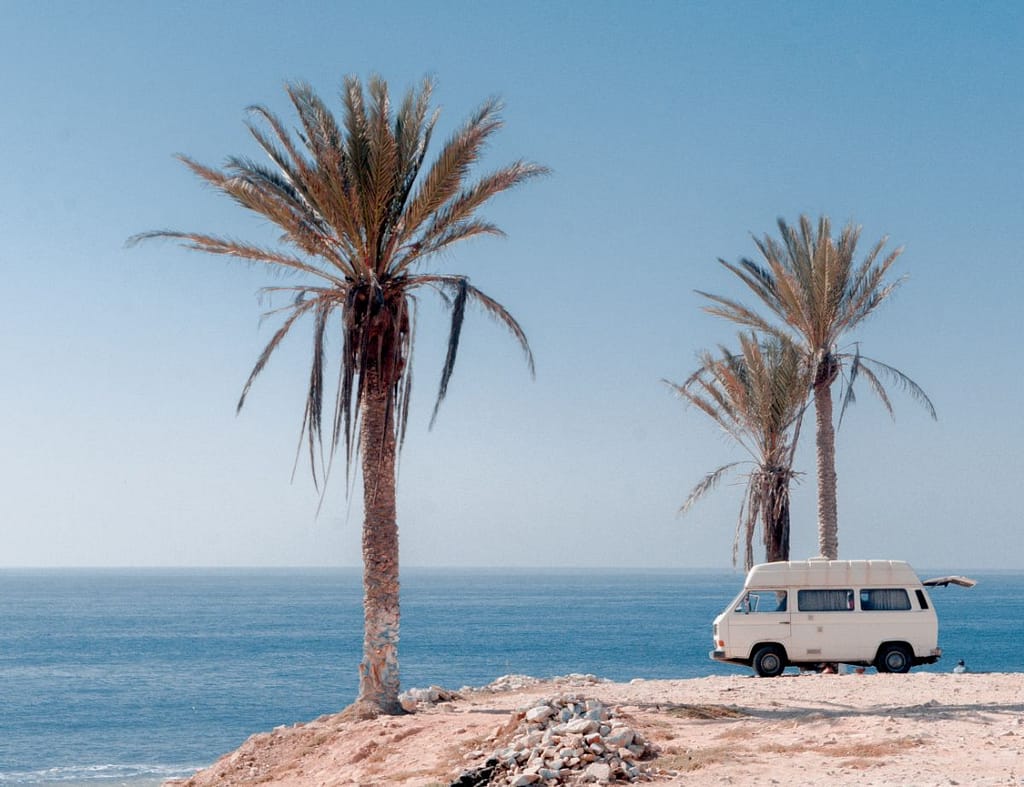
Capacity of Battery
The capacity of a deep cycle battery is represented in amp-hours (AH). Amp-hour essentially means the amount of current a battery can deliver in one hour.
Nowadays, batteries are given an amp-hour value and a time value in which the battery will be completely discharged. For example, they will say 200 Ah @ 20 hours. For easy understanding, it means you can run a load of 10 amp constantly over 20 hours for this battery to completely discharge. So, if you utilize only 5 amp constantly you can draw 40 hours out of this battery
It is now up to you to determine the load you will be putting on the battery. All RV appliances come with a number of amps they draw to run. You can combine the number of amps of the appliances running at a time and predict the amount of time your battery will last.
Batteries come in a huge range of capacities. These can range from milliamp-hours to 1000’s amp hours.
A major proportion of deep cycle batteries come in the range of 100 to 300 Ah. However, you can increase the capacity of your battery bank by adding more batteries to it. So, a couple of 100-Ah batteries connected in parallel will give you 200-Ah of storage.
Depth of Discharge (DoD) and Charge-Discharge Cycles
Depth of discharge can be termed as the capacity that is discharged from a charged battery. This is mostly presented as a percentage and ranges from 50% for most lead-acid and AGM batteries and about 100% for lithium batteries.
Thus, if you have a lead-acid battery at your hand, you essentially have 50% of that total capacity at your disposal. You can fully discharge this battery every once in a while, but it will adversely affect the battery life.
Charge-discharge cycles usually indicate the life of a battery. This is usually indicated combined with a DoD. A battery that gets discharged at 50% will give you more cycles as opposed to a battery that gets discharged 80%.
Different types of deep discharge batteries have a range of discharge cycles they can give. These can range from around 500 for lead-acid batteries at 50% DoD to 1000s of cycles for lithium batteries even at 100% DoD.
A battery which completes a single charge-discharge cycle in one day and has a life of 500 cycles will give you 500 days of working.
This way, a lead-acid battery only lasts around a couple of years, but a lithium battery can easily serve you for a decade or even more.
FAQs for Best RV Battery for Dry Camping
A 100-watt solar panel can give you 30-amp hours per day. You should match your solar capacity with that of your battery capacity. So, for a 100-Ah battery, you should have at least three 100-watt solar panels.
You would need a battery charger that matches the output of the generator and take it from the generator to the battery. A 230-volt generator has a nominal output of around 13 volts and that should charge your 100-Ah battery in around six hours.
Battle Born LiFePO4 is one of the best batteries available right now for boondocking
You can charge your deep cycle RV battery from a solar panel, a generator, and also from shore power using a battery charger.
Conclusion
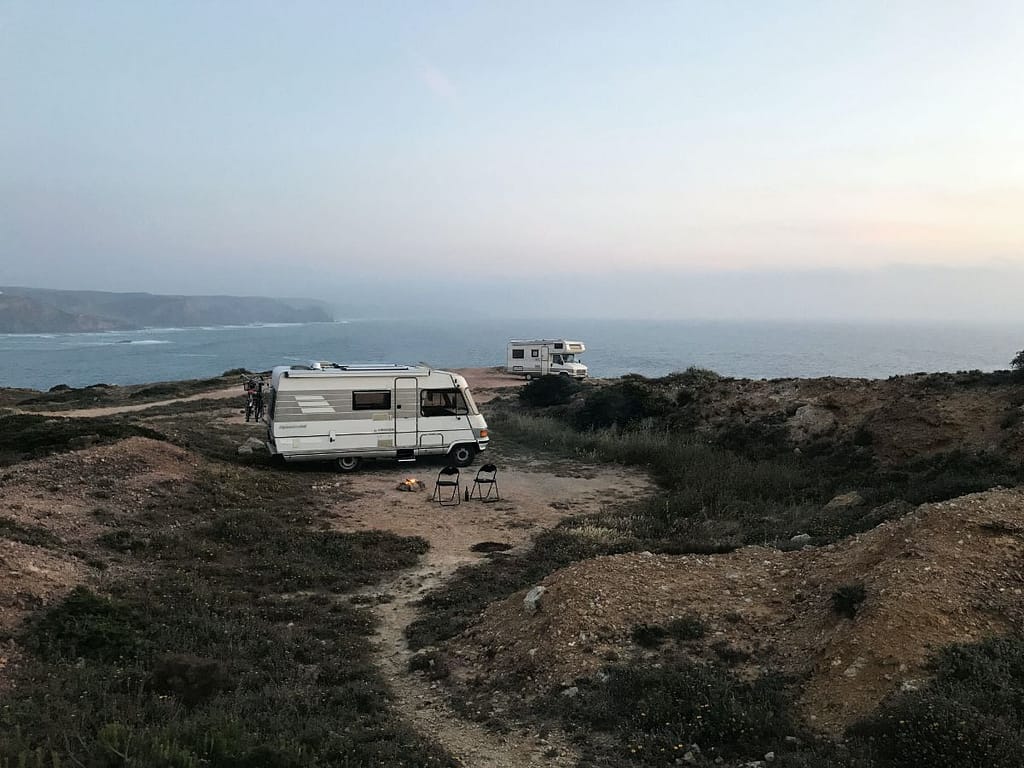
Dry camping can only be enjoyed if you are self-sufficient in power. And that is only possible if you have good-quality batteries at hand.
For RVs in general and for dry camping specifically, you need deep cycle batteries because they can withstand frequent charge-discharge cycles. Fortunately, now, we have a lot of options available in these batteries.
Lithium-ion batteries have changed the whole scope of batteries and batteries are more reliable than ever.
They are by far the best option when we talk about the best RV house batteries for full-time dry campers. However, they come at a hefty price, and the cost further increases if you try to add more batteries to your battery bank.
Therefore, they aren’t the best of options if you are an infrequent dry camper. For such people, lead-acid, AGM, and gel batteries present as more suitable options. All of them have their pros and cons, but they are good enough to serve these people well. Moreover, they come at highly affordable prices compared to lithium batteries.
In this piece, I have put forward some of the best batteries you can find in today’s market for dry camping. If you would ask for my personal favorite, it would be Battle Born 100 Ah LiFePO4 battery.
Later, I briefly described what went behind going with these options and how you can select one of yourself in the buyer’s guide.
I hope this piece was of value and helped you find one for your needs and preferences. If you still have any questions or queries, do comment below and I would love to respond.











